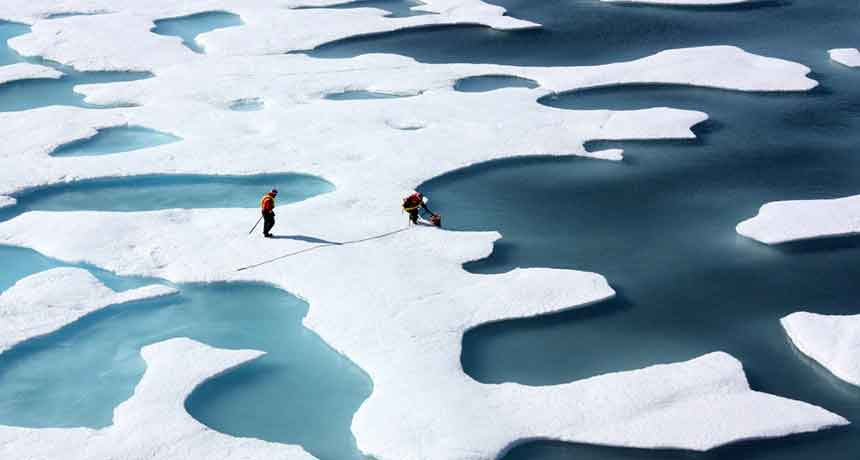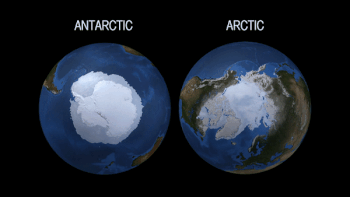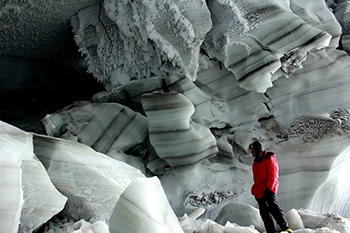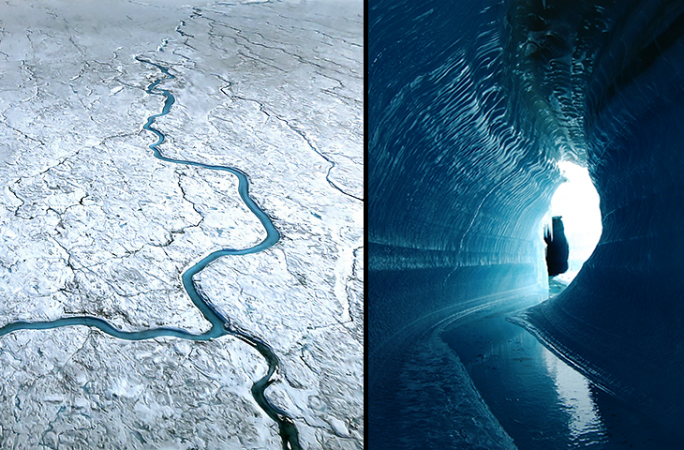Why Antarctica and the Arctic are polar opposites
The Earth’s north and south polar regions are responding quite differently to climate change

Melt ponds form on Arctic sea ice during the summer. Their being dark increases how much of the sun’s heat they will absorb (not reflect), speeding the rate at which they melt.
Kathryn Hansen/NASA
By Douglas Fox
The Arctic and Antarctic are the two coldest regions on Earth. Sitting at opposite poles, they might seem like mirror images of each other. But their environments are shaped by very different forces. And that’s why global warming is affecting them in very different ways.
These differences also help explain their effects on the rest of the planet.

At the north end of the world, the Arctic consists of an ocean enclosed by several large blocks of land: North America, Greenland, Europe and Asia.
Much of the Arctic Ocean is covered by a thin crust of sea ice, most of it 1 to 4 meters (3 to 13 feet) thick. It forms as the surface of the ocean freezes during winter. Some of this ice melts during the warm months. Arctic sea ice reaches its smallest area at the end of summer, in September, before it starts growing again.
Arctic sea ice has shrunken dramatically in recent years. The area of ice left at the end of summer is now about 40 percent less than it was in the early 1980s. Each year, on average, it decreases by another 82,000 square kilometers (32,000 square miles) — an area about the size of the state of Maine. The pace of sea-ice loss has “surprised a lot of people,” says Julienne Stroeve. She’s a polar scientist at the University of Manitoba in Canada. And she predicts that by 2040 the Arctic Ocean could be mostly ice free during summer.
The situation in Antarctica, at the south end of the world, is quite different. The sea ice here actually has increased a bit since 1980. This often confuses people. And climate skeptics sometimes take advantage of this confusion to mislead people. Those skeptics argue that the world is not actually getting warmer. They cite expanding Antarctic sea ice as evidence of this. But if you understand how the Arctic and Antarctic are different, then what’s happening down south makes sense.
Opposite personality
Antarctica is in some ways the opposite of the Arctic. Rather than water surrounded by land, it is land surrounded by water. And that difference has shaped the climate of Antarctica in major ways.
The Southern Ocean, which surrounds Antarctica, is the only place where a ring of ocean, unbroken by land, circles the planet. If you’ve ever crossed the Southern Ocean by ship, you will know it is some of the roughest water on Earth. The wind constantly whips the water into waves that can tower 10 to 12 meters (33 to 39 feet) — as tall as a three-story building. That wind always pushes the water eastward. It creates an ocean current that circles Antarctica. Such a current is known as circumpolar.
The Antarctic Circumpolar Current is the most powerful ocean current on the planet. It, and the winds that drive it, isolate Antarctica from the rest of the world. They keep Antarctica far colder than the Arctic.
The Arctic and parts of Antarctica are among the fastest-warming places on Earth. They are warming up to five times as quickly as the rest of the planet. But because these two regions start out at different temperatures, the same amount of warming has very different effects.
Much of the Arctic is only a little bit below freezing in summer, so just a couple degrees of warming means that much more of its sea ice will melt.
NASA Scientific Visualization Studio/YouTube
But, notes Stroeve, “The Antarctic is so much colder, that even if you raise it 5 degrees Celsius [9 degrees Fahrenheit], it’s still really cold.” So most of Antarctica’s sea ice is not melting — at least not yet. Antarctica saw record areas of sea ice in the winters of 2012 through 2014. But then Antarctic sea ice hit a new record low in March 2017, the end of its austral summer. Sea ice in the Antarctic dipped unusually low again in the Austral summer of 2018. And as of January 2019, it appears headed for a new record low.
Deeper water
The Arctic and Antarctic do look alike, however, in one important way: Glaciers in both places are losing lots of ice.

Glacial ice is different from sea ice. It forms from snow that falls onto land. Over thousands of years, the snow gradually compresses into solid ice. Antarctica’s glacial ice sheets are losing 250 billion tons of ice per year. Greenland, in the Arctic, is losing 280 billion tons of ice per year. And smaller glaciers in Arctic Alaska, Canada and Russia also are losing plenty of ice.
But even here, there are important differences between the two polar regions.
Most of the loss of Antarctica’s glacial ice can be blamed on warm ocean currents. This is because much of west Antarctica’s ice sits on “land” that dips below sea level. This ice sits in a broad bowl that drops more than 2,000 meters (6,600 feet) below sea level at its center. As the outer edge of west Antarctica’s ice retreats inland, toward the deepening center of this bowl, the edges of the ice will become ever more exposed to deep, warm water. This could cause west Antarctica to lose ice more rapidly over time.
Greenland also is losing ice around its edges to ocean melting. But here, much of its ice sits on higher ground. Greenland and smaller glaciers in the Arctic instead are getting hammered by warm summer air.
During summer, much of Greenland’s surface is dotted with blue ponds. They are formed by snow melt. Some of this water runs off the edge of the ice sheet in gushing rivers. Some also pours down deep cracks in the ice. Once it hits the bottom of the ice sheet, it flows on out to the ocean.
Scientists were surprised to learn in 2013 that much of this water from snow melt stays on the ice sheet. It does not even refreeze during winter. Instead, it trickles 10 to 20 meters (33 to 66 feet) into the snow. And even as air temperatures drop to –30 °C (–22 °F) during winter, this insulated water stays stubbornly liquid.

Warm ice
“Things are happening faster than we had predicted 10 years ago,” says Zoe Courville. She’s a materials engineer who studies Greenland’s ice sheet at the U.S. Army’s Cold Regions Research and Engineering Laboratory in Hanover, N.H.
In 2013, she and a team of scientists drilled a series of holes into the Greenland ice sheet. They measured the temperature of the snow and ice down to 10 meters (33 feet) below the surface. Since the 1960s, they found, this top upper layer of the ice sheet has warmed by as much as 5.7 degrees C (10.1 degrees F). This, explains Courville, is five times faster than the air has warmed!
Having a wetter surface could darken Greenland’s ice sheet. That will make it absorb more heat from the sun. Warmer ice is also “less rigid, not quite as strong,” notes Courville, so it could affect the ice sheet in other ways. She concludes: “I don’t think we know all of the implications of it yet.”
Rising Arctic temperatures are having many other impacts, too. Permafrost — soil frozen for thousands of years — has begun thawing. As the hard ground softens, houses have begun tilting and roads have started to crack apart. Stripped of sea ice, sections of the thawing Alaskan coastline are now crumbling. As buildings tumble into the waves, plans are being made to relocate some villages — such as Shishmaref, located on an island off the coast of Alaska.
Indeed, Stroeve points out that this is one very important way the Arctic differs from Antarctica: People actually live there. So as Earth warms, people in the high Arctic will feel the effects — in many cases long before the rest of the world sees the gradual effects of rising sea level due to the melting ice.
NASA Climate Change/YouTube







